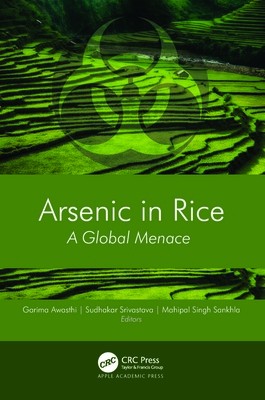
- We will send in 10–14 business days.
- Publisher: Apple Academic Press
- ISBN-10: 1774914662
- ISBN-13: 9781774914663
- Format: 15.2 x 22.9 x 1.8 cm, hardcover
- Language: English
- SAVE -10% with code: EXTRA
Arsenic in Rice (e-book) (used book) | bookbook.eu
Reviews
Description
This new volume addresses the arsenic-rice problem, covering arsenic in water and in soil and specifically arsenic in rice, offering effective mitigation strategies as well. Arsenic has been said to be one of the world's most toxic elements, infiltrating the food chain and finding its way into foods. Studies have recently detected high levels of arsenic in rice, which is a major concern since rice is a staple food for a large part of the world's population.
The volume first describes the problem of arsenic in rice in a nutshell. It goes on to deal with the status of arsenic contamination in paddy fields, particularly in the context of the soil-water chemistry of arsenic in the field conditions. The volume discusses the rhizospheric physiology of rice in paddy fields and how arsenic is transported inside the plant and how arsenic causes toxicity to rice plants. To deal with these points, the volume discusses the long-distance translocation of arsenic in rice, which will enable us to understand how this arsenic enters the plan and what it does to the plant. These chapters also discuss arsenic-induced phytotoxicity in rice plants after entry. The volume considers economic measures that can be taken to reduce the arsenic load inside the rice plant and grains and explains several techniques that can be utilized agronomically and that are environmentally safe. The biotechnological and nanotechnological methods that can be utilized to mitigate the arsenic stress in rice are considered as are the microbial-mediated techniques that can be applied to regulate arsenic in rice. Last but not least, the book describes all arsenic species present in rice reported to date.
The book provides an excellent update on the issue of arsenic in rice with the latest up-to-date information.
EXTRA 10 % discount with code: EXTRA
The promotion ends in 19d.22:12:12
The discount code is valid when purchasing from 10 €. Discounts do not stack.
- Publisher: Apple Academic Press
- ISBN-10: 1774914662
- ISBN-13: 9781774914663
- Format: 15.2 x 22.9 x 1.8 cm, hardcover
- Language: English English
This new volume addresses the arsenic-rice problem, covering arsenic in water and in soil and specifically arsenic in rice, offering effective mitigation strategies as well. Arsenic has been said to be one of the world's most toxic elements, infiltrating the food chain and finding its way into foods. Studies have recently detected high levels of arsenic in rice, which is a major concern since rice is a staple food for a large part of the world's population.
The volume first describes the problem of arsenic in rice in a nutshell. It goes on to deal with the status of arsenic contamination in paddy fields, particularly in the context of the soil-water chemistry of arsenic in the field conditions. The volume discusses the rhizospheric physiology of rice in paddy fields and how arsenic is transported inside the plant and how arsenic causes toxicity to rice plants. To deal with these points, the volume discusses the long-distance translocation of arsenic in rice, which will enable us to understand how this arsenic enters the plan and what it does to the plant. These chapters also discuss arsenic-induced phytotoxicity in rice plants after entry. The volume considers economic measures that can be taken to reduce the arsenic load inside the rice plant and grains and explains several techniques that can be utilized agronomically and that are environmentally safe. The biotechnological and nanotechnological methods that can be utilized to mitigate the arsenic stress in rice are considered as are the microbial-mediated techniques that can be applied to regulate arsenic in rice. Last but not least, the book describes all arsenic species present in rice reported to date.
The book provides an excellent update on the issue of arsenic in rice with the latest up-to-date information.


Reviews